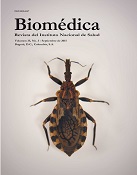Influence of magnetic field on the growth of pathogen microorganisms isolated from the indoor environment at the Archivo Nacional de la República de Cuba
Abstract
Introduction: Electromagnetic pollution has been detected at the Archivo Nacional de la República de Cuba and the influence of extremely low frequency magnetic fields could be quantified with pathogenic microorganisms isolated from the indoor environment.
Objective: To quantify the influence of an extremely low frequency magnetic field on the growth of pathogenic microorganisms isolated from the environment at the Archivo Nacional.
Materials and methods: We used five microorganisms isolated at the Archivo Nacional: Streptococcus sp. (1), Listeria sp. (2) and Candida guillermondii (3), and Escherichia coli ATCC 25922 (4) and Saccharomyces cerevisiae (5) as references. We applied this magnetic field of extremely low frequency, 60 Hz/220 V (3 mT), for two hours to these microorganisms on three culture tubes with distilled water and nutrient broth. Then we inoculated 0.1 mL in the following solid culture mediums on Petri dishes: CromoCen SC Agar (1 and 2), Potato Dextrose Agar (3), CromoCen DC 4227 (4) and Malt Extract Agar (5). The colonies were counted (log CFU/mL) by digital processing of the images of Petri dishes using the MatLab® tool.
Results: We observed a statistically significant stimulation (p≤0.05) in the quantity of treated colonies as compared to controls, which was higher in nutrient broth than in distilled water, and in bacteria (nutrient broth and treated colonies: 9.43 to 10.62 CFU/mL) as compared with yeasts (nutrient broth-treated colonies: 8.31 to 8.79 CFU/mL). In decreasing order, stimulation was as follows: Listeria sp., E. coli ATCC 25922, Streptococcus sp., C. guillermondii and S. cerevisiae.
Conclusion: We concluded that the magnetic field applied had a stimulating effect on the microorganisms under study, which increases the risk to the health of staff and visitors at the Archivo Nacional.
Downloads
Some similar items:
- Nadia Yadira Castañeda, Jacqueline Chaparro-Olaya, Jaime E. Castellanos, Production and characterization of a polyclonal antibody against rabies virus phosphoprotein , Biomedica: Vol. 27 No. 2 (2007)
- Nacxiry Fonseca, María Claudia Vela, Elizabeth Castañeda, Evaluation of a medium for the conservation of Streptococcus pneumoniae in nasopharyngeal isolates , Biomedica: Vol. 20 No. 3 (2000)
- Catalina de Bedout, Julio Ayabaca, Ricardo Vega, Matilde Méndez, Axel R. Santiago, María Lucrecia Pabón, Angela Tabares, Myrtha Arango, Angela Restrepo, Vance Newell, Evaluation of Candida species' susceptibility to fluconazole with the disk diffusion method. , Biomedica: Vol. 23 No. 1 (2003)
- Orlando Torres-Fernández, Nelly Ordóñez, Comparative effect of osmium tetroxide and ruthenium tetroxide on Penicillium sp. hyphae and Saccharomyces cerevisiae fungal cell wall ultrastructure. , Biomedica: Vol. 23 No. 2 (2003)
- Alfonso Benítez-Páez, Sonia Cárdenas-Brito, Mauricio Corredor, Magda Villarroya, María Eugenia Armengod, Impairing methylations at ribosome RNA, a point mutation-dependent strategy for aminoglycoside resistance: The rsmG case , Biomedica: Vol. 34 (2014): Abril, Suplemento 1, Resistencia bacteriana
- Dihadenys Lemus, Miguel Echemendía, Raúl Díaz, Alina Llop, María Josefa Llanes, Surveillance of antituberculosis-drug resistance in Cuba, 2010-2011 , Biomedica: Vol. 34 (2014): Abril, Suplemento 1, Resistencia bacteriana
- Adriana Jiménez, Alejandra Alvarado, Felipe Gómez, Germán Carrero, Claudia Fajardo, Risk factors associated with the isolation of extended spectrum betalactamases producing Escherichia coli or Klebsiella pneumoniae in a tertiary care hospital in Colombia , Biomedica: Vol. 34 (2014): Abril, Suplemento 1, Resistencia bacteriana
- Elvia Michelli, Adriana Millán, Hectorina Rodulfo, Mirian Michelli, Jesús Luiggi, Numirin Carreño, Marcos de Donato, Identification of enteropathogenic Escherichia coli in children with acute diarrheic syndrome from Sucre State, Venezuela , Biomedica: Vol. 36 (2016): Suplemento 1, Microbiología médica
- Mónica Tatiana Herrera, Jhon Jhamilton Artunduaga, Claudia Cristina Ortiz, Rodrigo Gonzalo Torres, Synthesis of antibiotic loaded polylactic acid nanoparticles and their antibacterial activity against Escherichia coli O157:H7 and methicillin-resistant Staphylococcus aureus , Biomedica: Vol. 37 No. 1 (2017)
- Yasmin Varela, Beatriz Millán, María Araque, Genetic diversity of extraintestinal Escherichia coli strains producers of beta-lactamases TEM, SHV and CTX-M associated with healthcare , Biomedica: Vol. 37 No. 2 (2017)
| Article metrics | |
|---|---|
| Abstract views | |
| Galley vies | |
| PDF Views | |
| HTML views | |
| Other views | |


























